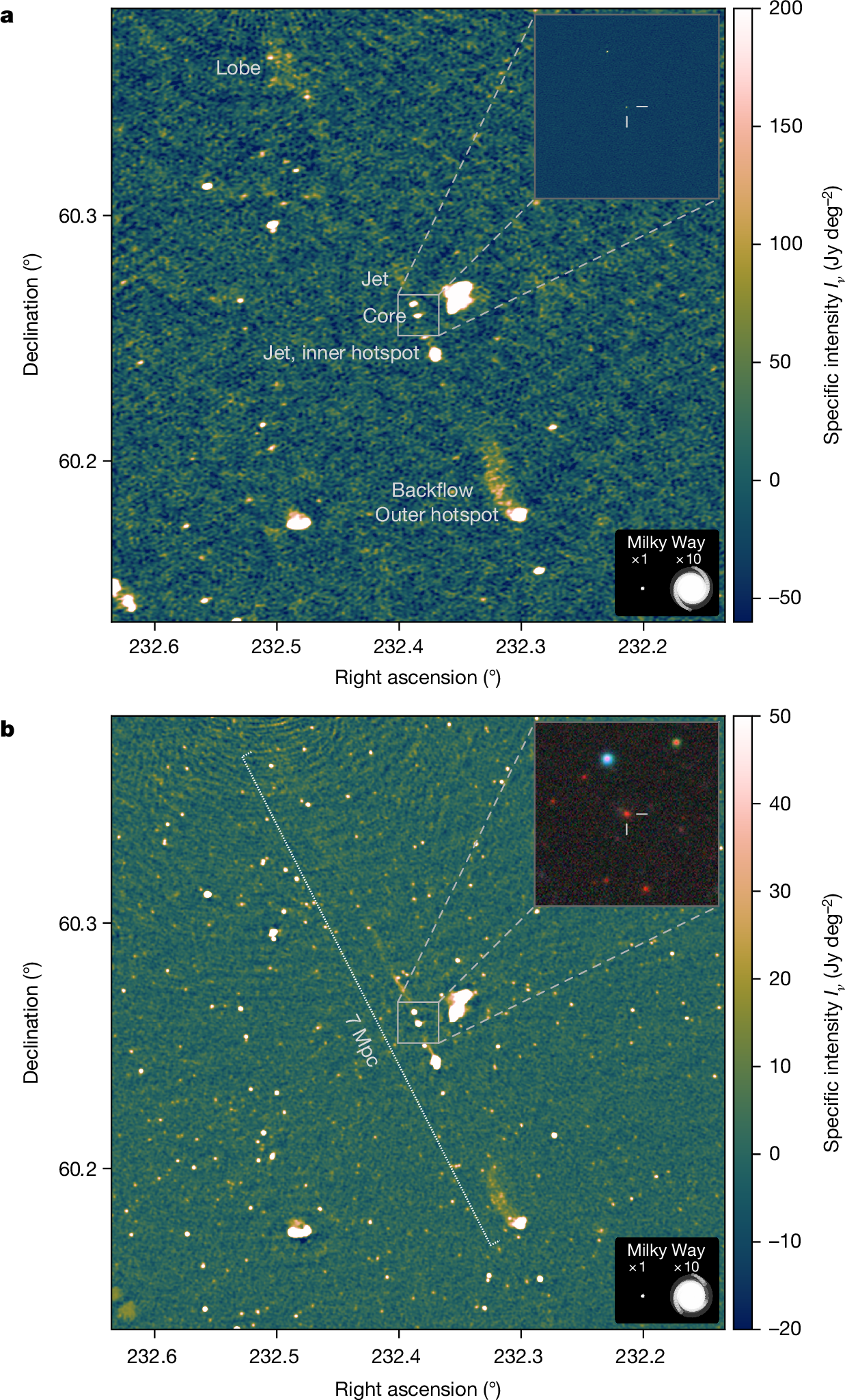dx.doi.org/10.1038/s41586-024-07879-y
Preview meta tags from the dx.doi.org website.
Linked Hostnames
35- 93 links todx.doi.org
- 61 links toscholar.google.com
- 60 links todoi.org
- 43 links toadsabs.harvard.edu
- 26 links towww.nature.com
- 13 links toscholar.google.co.uk
- 13 links towww.ncbi.nlm.nih.gov
- 12 links toorcid.org
Thumbnail

Search Engine Appearance
Black hole jets on the scale of the cosmic web - Nature
When sustained for megayears (refs. 1,2), high-power jets from supermassive black holes (SMBHs) become the largest galaxy-made structures in the Universe3. By pumping electrons, atomic nuclei and magnetic fields into the intergalactic medium (IGM), these energetic flows affect the distribution of matter and magnetism in the cosmic web4–6 and could have a sweeping cosmological influence if they reached far at early epochs. For the past 50 years, the known size range of black hole jet pairs ended at 4.6–5.0 Mpc (refs. 7–9), or 20–30% of a cosmic void radius in the Local Universe10. An observational lack of longer jets, as well as theoretical results11, thus suggested a growth limit at about 5 Mpc (ref. 12). Here we report observations of a radio structure spanning about 7 Mpc, or roughly 66% of a coeval cosmic void radius, apparently generated by a black hole between $${4.4}_{-0.7}^{+0.2}$$ and 6.3 Gyr after the Big Bang. The structure consists of a northern lobe, a northern jet, a core, a southern jet with an inner hotspot and a southern outer hotspot with a backflow. This system demonstrates that jets can avoid destruction by magnetohydrodynamical instabilities over cosmological distances, even at epochs when the Universe was 7 to $$1{5}_{-2}^{+6}$$ times denser than it is today. How jets can retain such long-lived coherence is unknown at present. Radio images reveal distant black hole jets of cosmological length, suggesting that the environmental impact of supermassive black holes extends further in space and time than previously thought.
Bing
Black hole jets on the scale of the cosmic web - Nature
When sustained for megayears (refs. 1,2), high-power jets from supermassive black holes (SMBHs) become the largest galaxy-made structures in the Universe3. By pumping electrons, atomic nuclei and magnetic fields into the intergalactic medium (IGM), these energetic flows affect the distribution of matter and magnetism in the cosmic web4–6 and could have a sweeping cosmological influence if they reached far at early epochs. For the past 50 years, the known size range of black hole jet pairs ended at 4.6–5.0 Mpc (refs. 7–9), or 20–30% of a cosmic void radius in the Local Universe10. An observational lack of longer jets, as well as theoretical results11, thus suggested a growth limit at about 5 Mpc (ref. 12). Here we report observations of a radio structure spanning about 7 Mpc, or roughly 66% of a coeval cosmic void radius, apparently generated by a black hole between $${4.4}_{-0.7}^{+0.2}$$ and 6.3 Gyr after the Big Bang. The structure consists of a northern lobe, a northern jet, a core, a southern jet with an inner hotspot and a southern outer hotspot with a backflow. This system demonstrates that jets can avoid destruction by magnetohydrodynamical instabilities over cosmological distances, even at epochs when the Universe was 7 to $$1{5}_{-2}^{+6}$$ times denser than it is today. How jets can retain such long-lived coherence is unknown at present. Radio images reveal distant black hole jets of cosmological length, suggesting that the environmental impact of supermassive black holes extends further in space and time than previously thought.
DuckDuckGo
Black hole jets on the scale of the cosmic web - Nature
When sustained for megayears (refs. 1,2), high-power jets from supermassive black holes (SMBHs) become the largest galaxy-made structures in the Universe3. By pumping electrons, atomic nuclei and magnetic fields into the intergalactic medium (IGM), these energetic flows affect the distribution of matter and magnetism in the cosmic web4–6 and could have a sweeping cosmological influence if they reached far at early epochs. For the past 50 years, the known size range of black hole jet pairs ended at 4.6–5.0 Mpc (refs. 7–9), or 20–30% of a cosmic void radius in the Local Universe10. An observational lack of longer jets, as well as theoretical results11, thus suggested a growth limit at about 5 Mpc (ref. 12). Here we report observations of a radio structure spanning about 7 Mpc, or roughly 66% of a coeval cosmic void radius, apparently generated by a black hole between $${4.4}_{-0.7}^{+0.2}$$ and 6.3 Gyr after the Big Bang. The structure consists of a northern lobe, a northern jet, a core, a southern jet with an inner hotspot and a southern outer hotspot with a backflow. This system demonstrates that jets can avoid destruction by magnetohydrodynamical instabilities over cosmological distances, even at epochs when the Universe was 7 to $$1{5}_{-2}^{+6}$$ times denser than it is today. How jets can retain such long-lived coherence is unknown at present. Radio images reveal distant black hole jets of cosmological length, suggesting that the environmental impact of supermassive black holes extends further in space and time than previously thought.
General Meta Tags
179- titleBlack hole jets on the scale of the cosmic web | Nature
- titleClose banner
- titleClose banner
- X-UA-CompatibleIE=edge
- applicable-devicepc,mobile
Open Graph Meta Tags
6- og:urlhttps://www.nature.com/articles/s41586-024-07879-y
- og:typearticle
- og:site_nameNature
- og:titleBlack hole jets on the scale of the cosmic web - Nature
- og:descriptionRadio images reveal distant black hole jets of cosmological length, suggesting that the environmental impact of supermassive black holes extends further in space and time than previously thought.
Twitter Meta Tags
6- twitter:site@nature
- twitter:cardsummary_large_image
- twitter:image:altContent cover image
- twitter:titleBlack hole jets on the scale of the cosmic web
- twitter:descriptionNature - Radio images reveal distant black hole jets of cosmological length, suggesting that the environmental impact of supermassive black holes extends further in space and time than previously...
Item Prop Meta Tags
4- position1
- position2
- position3
- publisherSpringer Nature
Link Tags
15- alternatehttps://www.nature.com/nature.rss
- apple-touch-icon/static/images/favicons/nature/apple-touch-icon-f39cb19454.png
- canonicalhttps://www.nature.com/articles/s41586-024-07879-y
- icon/static/images/favicons/nature/favicon-48x48-b52890008c.png
- icon/static/images/favicons/nature/favicon-32x32-3fe59ece92.png
Emails
1Links
366- http://adsabs.harvard.edu/cgi-bin/nph-data_query?link_type=ABSTRACT&bibcode=1974Natur.250..625W
- http://adsabs.harvard.edu/cgi-bin/nph-data_query?link_type=ABSTRACT&bibcode=1977MNRAS.179..433B
- http://adsabs.harvard.edu/cgi-bin/nph-data_query?link_type=ABSTRACT&bibcode=1995PASP..107..375O
- http://adsabs.harvard.edu/cgi-bin/nph-data_query?link_type=ABSTRACT&bibcode=2004ApJ...604..534S
- http://adsabs.harvard.edu/cgi-bin/nph-data_query?link_type=ABSTRACT&bibcode=2008ApJ...679..149M